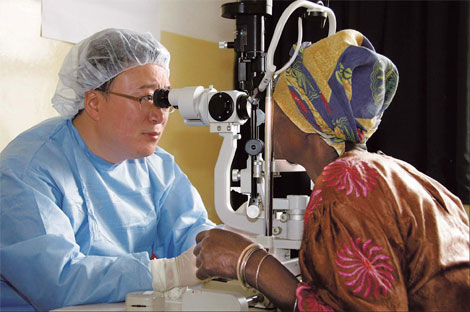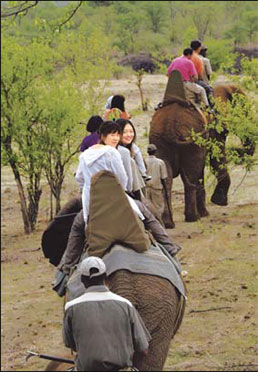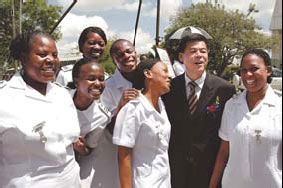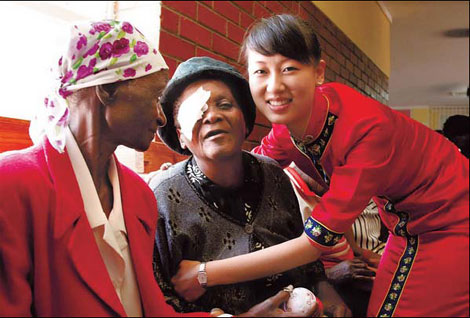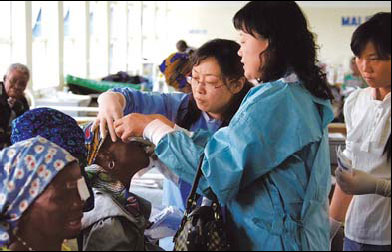Life and Leisure
Seeing eye to eye
By Huang Yiming (China Daily)
Updated: 2010-12-08 08:03
 |
Large Medium Small |
|
A Chinese ophthalmologist examines a cataract sufferer in Zimbabwe. Photos by Huang Yiming / China Daily |
A team of Chinese ophthalmologists has been helping thousands blinded by cataracts in Africa. Huang Yiming reports
In late November, at a hospital 30 km from Zimbabwe's capital Harare, Thicayo, an elderly woman, shouts in glee as the gauze covering her eyes is slowly rolled off - "Mr president! How wonderful it is to see you." Zimbabwean President Robert Mugabe was there to welcome a team of Chinese ophthalmologists for the non-profit project, 2010 Journey of Bringing Light to Africa, aimed at helping people blinded by cataracts and providing medicines and training at local hospitals.
"The project opens up a very promising mode of cooperation in joint efforts to battle blindness," Mugabe said, "and shows the sincere desire and resolution of the Chinese people to offer a (helping) hand to the African people.
|
Members of the Chinese delegation travel on the backs of elephants in Zimbabwe. |
"The brotherly ties between the two sides have been strengthened."
Thicayo's cataracts had left her blind for seven years and she said she was really grateful to the Chinese medical team for restoring her sight, that has let her see her grandson for the first time.
She is among an estimated 120,000 blinded by cataracts in Zimbabwe, of whom only 5,000 receive treatment every year at the hands of 20 native ophthalmologists, according to Zimbabwean statistics.
Lack of access to drugs and surgery, together with the inability to pay, leave many Zimbabweans at risk of permanent loss of sight.
Some 300 patients were among the lucky few to be treated by Chinese doctors from Nov 19 to 24 in the capital.
Another group of 20 Chinese doctors were busy in neighboring Malawi, helping another 300 cataract sufferers. The country has 70,000 people blinded by cataracts, of whom only a few can be treated by the available medical facilities.
Many of those treated said they felt like they had experienced a miracle.
The African initiative is part of the Journeys Bring Light Program of the National Organization for the Prevention of Blindness and Beijing Tongren Hospital, financed by companies such as Hainan Airlines.
The program benefits more than 30,000 in China, especially in remote areas.
Since 2008, teams of eye doctors under the program have been traveling to neighboring countries such as Cambodia, Vietnam and Mongolia.
|
Chinese ambassador Xin Shukang with doctors and nurses at a hospital. |
The dispatch of the 2010 team to Africa marks the 10th anniversary of the Forum on China-Africa Cooperation, says Chen Feng, chairman of Hainan Airlines, one of the sponsors.
Chen says it is a gift to the African people who have been helping Chinese enterprises to establish their businesses there, especially in infrastructure.
The project has taken the country's top ophthalmologists and the most-advanced medical equipment to the African people.
The Chinese doctors also train their African peers.
Zhu Siquan, one of the team's star ophthalmologists, is an experienced surgeon from Tongren Hospital known for his swift operations. Despite the summer dryness and heat in southern Africa, the doctor removed one cataract every three minutes, on average.
"I feel the warmth of the people and am content to bring light to more people," he says.
|
Zhang Lu, a representative of Hainan Airlines, visits a woman suffering from cataract. |
|
A warm welcome ceremony is staged at Harare airport. |
|
Hu Ailian (second from right), a member of the Chinese ophthalmologist team, checks the condition of several patients. |
